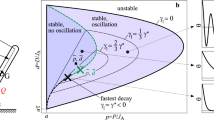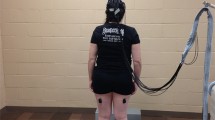Abstract.
We analyze the stochastic structure of postural sway and demonstrate that this structure imposes important constraints on models of postural control. Linear stochastic models of various orders were fit to the center-of-mass trajectories of subjects during quiet stance in four sensory conditions: (i) light touch and vision, (ii) light touch, (iii) vision, and (iv) neither touch nor vision. For each subject and condition, the model of appropriate order was determined, and this model was characterized by the eigenvalues and coefficients of its autocovariance function. In most cases, postural-sway trajectories were similar to those produced by a third-order model with eigenvalues corresponding to a slow first-order decay plus a faster-decaying damped oscillation. The slow-decay fraction, which we define as the slow-decay autocovariance coefficient divided by the total variance, was usually near 1. We compare the stochastic structure of our data to two linear control-theory models: (i) a proportional–integral–derivative control model in which the postural system's state is assumed to be known, and (ii) an optimal-control model in which the system's state is estimated based on noisy multisensory information using a Kalman filter. Under certain assumptions, both models have eigenvalues consistent with our results. However, the slow-decay fraction predicted by both models is less than we observe. We show that our results are more consistent with a modification of the optimal-control model in which noise is added to the computations performed by the state estimator. This modified model has a slow-decay fraction near 1 in a parameter regime in which sensory information related to the body's velocity is more accurate than sensory information related to position and acceleration. These findings suggest that: (i) computation noise is responsible for much of the variance observed in postural sway, and (ii) the postural control system under the conditions tested resides in the regime of accurate velocity information.
Similar content being viewed by others
Author information
Authors and Affiliations
Additional information
Received: 20 March 2001 / Accepted: 17 April 2002
Acknowledgements. We thank Tjeerd Dijkstra for bringing the slow-decay component of postural sway to our attention. Funding for this research was provided by National Institutes of Health grant R29 N35070–01A2, John J. Jeka, PI.
Correspondence to: T. Kiemel (Tel.: +1-301-4056176, Fax: +1-301-3149358 e-mail: kiemel@glue.umd.edu)
Rights and permissions
About this article
Cite this article
Kiemel, T., Oie, K. & Jeka, J. Multisensory fusion and the stochastic structure of postural sway. Biol Cybern 87, 262–277 (2002). https://doi.org/10.1007/s00422-002-0333-2
Issue Date:
DOI: https://doi.org/10.1007/s00422-002-0333-2




